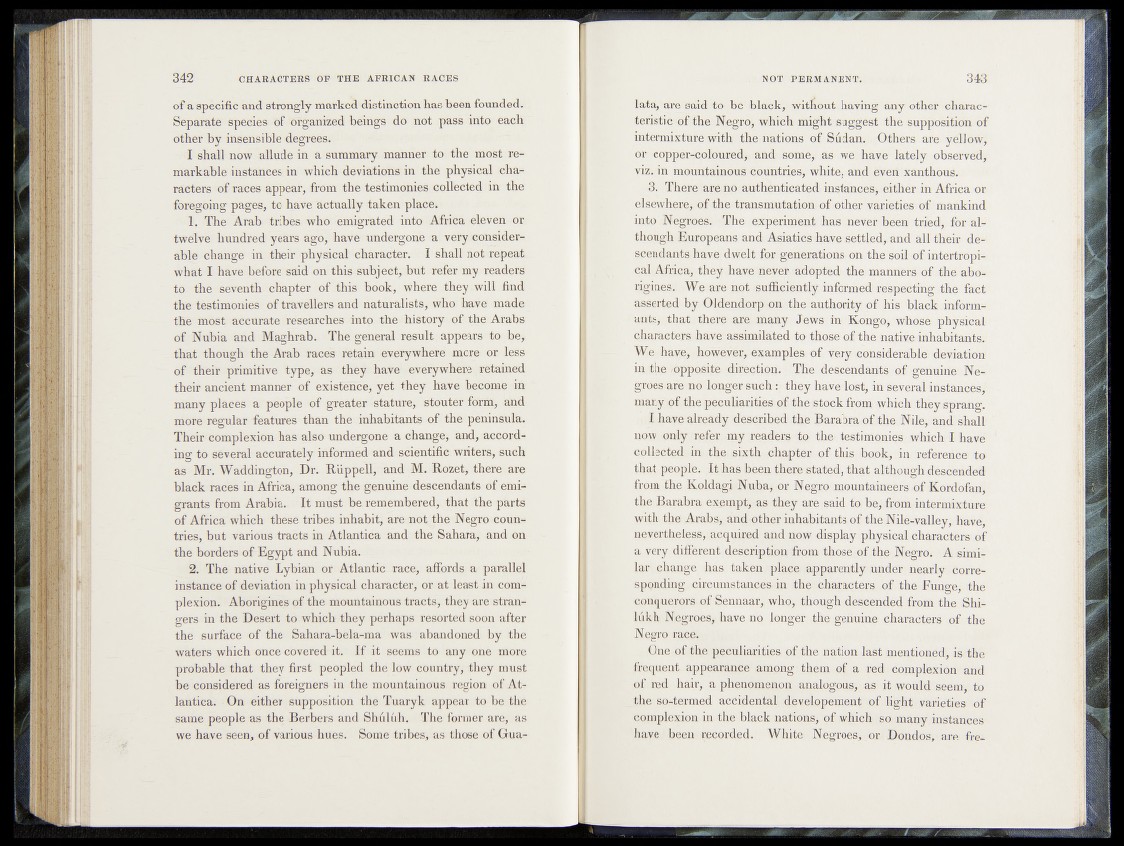
of a specific fetid strongly marked distinction has been founded.
Separate species öf organized beings do not pass into each
other by insensible degrees.
I shall now allude in a summary manner to the most remarkable
instances in which deviations in the physical characters
of races appear, from the testimonies collected in the
foregoing pages, to have actually taken place.
1. The Arab tribes who emigrated into Africa eleven or
twelve hundred years ago, have undergone a very considerable
change in their physical character. I shall not repeat
what I have before said on this subject, but refer-my readers
to the seventh chapter of this book, where they will find
the testimonies of travellers and naturalists, who have made
the most accurate researches into the history of the Arabs
of Nubia and Maghrab. The general result appears to be,
that though the Arab races retain everywhere more or less
of their primitive type, as they have everywhere retained
their ancient manner of existence, yet they have become in
m a n y places a people of greater stature, stouter form, and
more regular features than the inhabitants of the peninsula.
Their complexion has also undergone a change, and, according
to several accurately informed and scientific writers, such
as Mr, Waddington, Dr. Büppell, and M. Rozet, there are
black races in Africa, among the genuine descendants of emigrants
from Arabia. It must be remembered, that the pferts
of Africa which these tribes inhabit, are not the Negro countries,
but various tracts in Atlantica and the Sahara, and on
the borders of Egypt and Nubia.
2. The native Lybian or Atlantic race, affords a parallel
instance of deviation in physical character, or at least in complexion.
Aborigines of the mountainous tracts, they are strangers
in the Desert to which they perhaps resorted soon after
the surface of the Sahara-bela-ma was, abandoned by the
waters which once covered it. If it seems to any one more
probable that they first peopled the low country, they must
be considered as foreigners in the mountainous region of Atlantica.
On either supposition the Tuaryk appear to be the
same people as the; Berbers and Shülüh. The former are, as
we have seen, of various hues. Some tribes, as those of Gualata,
al’e saidvto- be black, without having any other charac-
teristic'ofdhetNfe.gjP®,' which might suggest the supposition of
ipJti^mlxtûre with^the-- nations of Sudan.’ Others are. yellow,
or;copper-coloured, and some, as we. have lately observed,
vi^.-in mountainous, countries, white, and f event xanthous.
■ 3. There are no authenticated; instanfeefey either in Africa or
elsewhere,yofi the .transmutation- of other varieties'of mankind
into 'Negroes.' The, experiment- has never been tried, forsah-
though Euÿepqans’and Asiatics-have settled, and all their descendants
have; dwelt* for generations, on the soil -,of intertropi-
cal Africa, they have.feievep' adopted the manners of the abol
i ! » ^ We are not sufficiently informed^ppfefetlng -jthe fact
asserted by Oldendorp on the authority of^his black informants,
that there are many Jews in Kongo^whose physical
u|iaraefej|sîhàve assimilated to th ^é the native inhabitants.
We have, however, examples of very considerable deviation
in the Opposite direction. The descendants -of-genuine Negroes
«are no longer such rwthey havë«4dst, in Several instances,
many of the peculiarities, of the stock from, which they sprang.
I have already described the Barabra of the Nile, and shall
now only refer my readers to the- testimonies which I have
collected in the-sixth chapter of this book, in reference to
that people. It has been there stated, that although descended
from the Koldagi Nuba, or Negro mountaineers of Kordofan,
the Barabra exempt, as they are said fo be&from 'intermixture
with the Arabs, and other inhabitants,of the-Nile-valley, have,
nevertheless, acquired and now display physical characters of
a very different description from those of the Negro. A similar
change has taken plaee apparently under nearly corresponding
circumstances- in the characters of the Funge, the
conquerors of Sennaar, who, though descended from the Shi-
lukh Negroes, have no longer the genuine characters of the
Negro race.
One of the peculiarities of the nation last mentioned, is the
frequent appearance among them of a red complexion and
of red hair, a phenomenon analogous, as it would seem, to
the so-termed accidental dpvelopement ofolight varieties of
complexion in the black nations, of which so many instances
have been recorded. White Negroes, or Dondos, are fre